The word for bread in Estonian is leib. In this northern Baltic country, leib is a hearty, black rye sourdough bread, often studded with seeds, heavy enough that carrying it home from the bakery might constitute your daily exercise. And it is delicious simply slathered with butter and sprinkled with sea salt crystals, as it is served in most restaurants in Tallinn, Estonia’s seaside capital.
Leib is also the name of one of our favourite restaurants in Tallinn, where the dark bread was a perfect match for the best beet borsch I have ever eaten, intensely flavoured with three cuts of beef in a rich broth that had simmered for 12 hours, laced with a bracing hit of vinegar and garnished generously with dill.
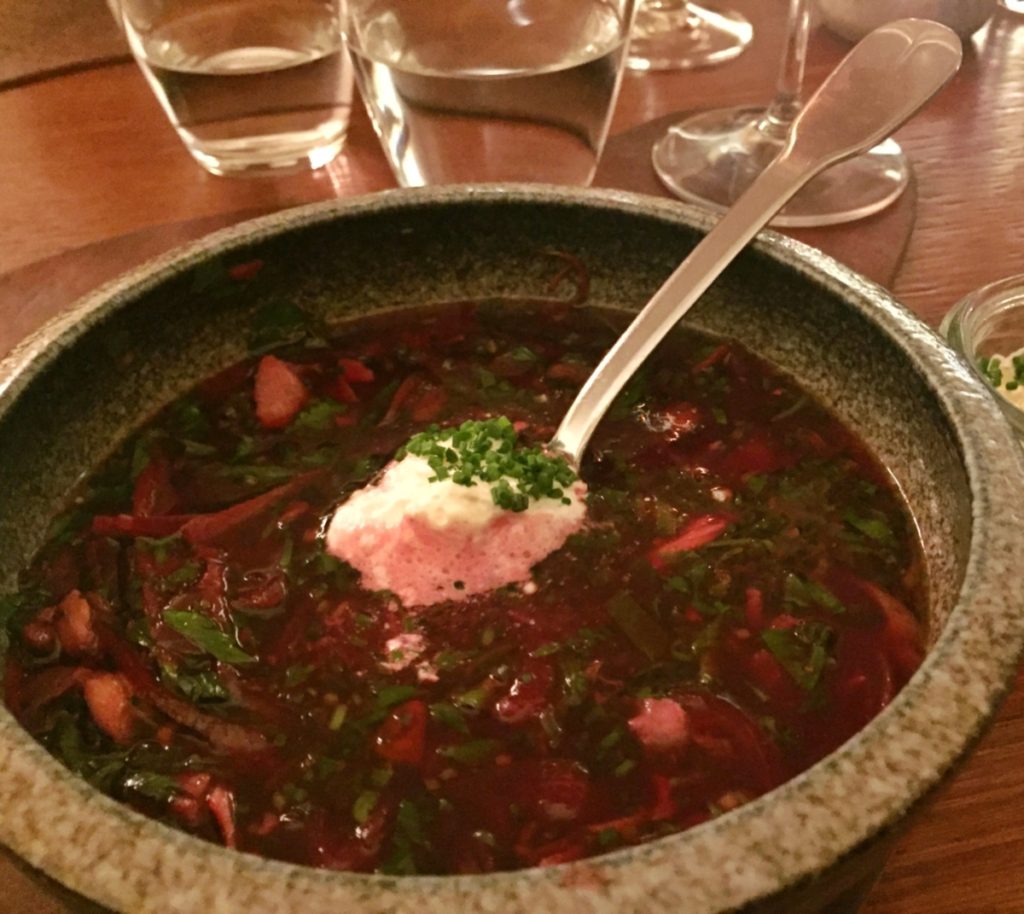
Sirloin of venison was served with lentils and a red wine sauce enriched with marrow. And a fillet of pike-perch floated on an astonishing pool of caramelized whey.
Modern Estonian cuisine, we find, is a creative mix of traditional ingredients plucked from the sea or foraged from the forest, elevated with techniques old and new, such as smoking and fermenting. It has influences of cuisines from neighbouring Baltic countries like Latvia and Lithuania, and former rulers like the Danes, Swedes, Germans and Russians, but still retains uniquely Estonian touches, so cucumbers and herring are salted rather than pickled or marinated, for example.
Estonia’s history is a long and often sad tale of occupation. It is situated in a prime location on the Baltic Sea with easy access to Finland, Russia, Sweden and other Nordic nations. All have left their mark, in terms of architecture, culture and food.
The country achieved independence in 1918, only to have it crushed brutally in the Soviet invasion of 1940. Estonia declared its independence once again in 1991.
Centuries of hardship have made Estonians especially proud – of their culture, their language and their traditions, which they express most profoundly in song. In fact, Estonians will quickly tell you they sang their way to freedom, as independence was achieved not with bloodshed, but with music. They call themselves ‘The Singing Nation.’
Their independence was given impetus by a peaceful demonstration in 1989 called ‘The Baltic Way,’ where approximately two million people from the three Baltic countries joined hands, forming a 600-kilometre-long chain through Estonia, Latvia and Lithuania, all united in their efforts towards freedom.
The first Estonian Song Festival was held in 1869 (in the city of Tartu) and has been celebrated in Tallinn every five years since. The 150th anniversary was celebrated in July, 2019 with more than 35,000 singers, mostly in traditional dress, gathered on the dramatic outdoor Song Festival Stage, with more than 100,000 spectators on the grassy hill overlooking the stage who, tears streaming down their cheeks, sang along.
In fact, my reason for going to Estonia was for another music festival where we heard some of the world’s – yes the world’s – finest choirs and ensembles performing in a myriad of Tallinn’s beautiful churches and historic venues. Any music lover should peruse the musical offerings in advance, or upon arrival in Tallinn.
And the tourist office in the medieval centre of the Old Town is a great starting point for any visit to Tallinn — there they offer free, two-hour guided walking tours every day which are informative, lively and funny.
We climbed to the Upper Town, Toompea, former home of the nobility, where Toompea Castle, a 13th-century stone fortress, stands high up on a limestone cliff. At the front is a pink Baroque palace which houses today’s parliament. Facing it is the imposing Russian Orthodox Cathedral with its five onion domes, named for Alexander Nevsky, who fought the Teutonic Knights on Lake Peipus on the eastern border of Estonia and Russia in 1242. The church is still in use for Tallinn’s small Russian Orthodox population and remains one of the city’s most impressive monuments, dominating the skyline.
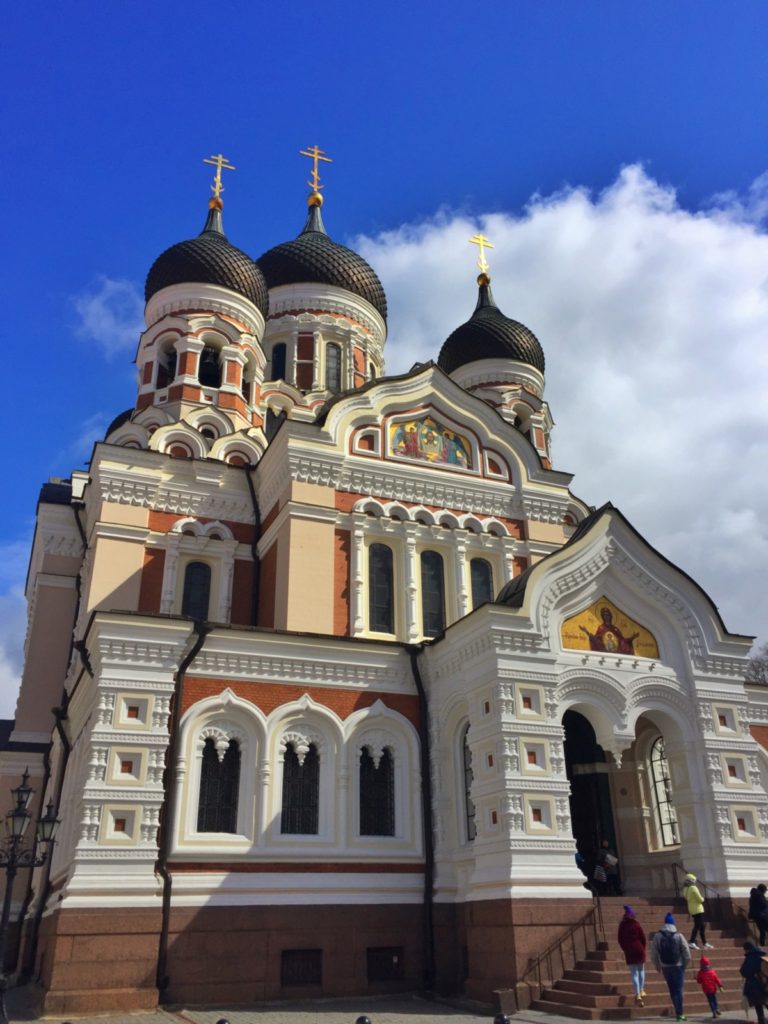
We marvel at the beautiful and confounding – yet musical – Estonian language, part of the Finno-Ugric group. And we chuckle at names like Kiek-in-de-Kök; Tall Hermann Tower; and Fat Margaret Tower, which we can see from one of the viewing terraces on Toompea. That magnificent view also takes in the harbour, the maze of red roofs, and the enormous 124-metre spire of St Olav’s Church, which has been struck by lightning an astonishing 10 times.
Tallinn revels in setting records; for example, the slender Town Hall in the lower part of the Old Town is celebrated as the oldest surviving Gothic Town Hall in Northern Europe. Across the square is the oldest continually running apothecary in Europe, now part museum, part functioning pharmacy. So while we were ogling the old jars of herbs and weird pharmaceutical implements, tourists were lining up nearby to purchase modern cold remedies.
Not far from that is the oldest cafe in Tallinn, Maiasmokk, established in 1864, still oozing with old world atmosphere, where talented women spend their days decorating intricate marzipan confections that will be gobbled up in seconds. This is also a handy place to pick up local Kalev chocolate, although it is currently rivalled by newcomer Chocolala’s award-winning handmade chocolates, with exquisite presentation and intriguing flavours, like lemon-rosemary and salted birch-sap caramel.
The Lower Town, formerly home to merchants and craftsmen, was originally called Reval, which is also the name of a popular – and very good – chain of cafes frequented by locals. The Town Hall presides over the magnificent central square lined with picturesque facades, today mostly restaurants. The square has always been the focal point of civic activity, and still hosts festivals, markets and celebrations.
Tallinn’s Old Town is pretty at every turn and easily navigable on foot, although I did manage to get lost on its winding lanes at least a couple of times a day. The wobbly, cobbled streets force us to slow our pace and take the time to admire the stunning and well-maintained Gothic architecture, including buildings of the former guilds, like the Great Guild (1410) and Brotherhood of the Blackheads (1597). Twenty of the original 46 towers of the well preserved city wall are still extant, all contributing to a harmonious ensemble, listed as one of UNESCO’s World Heritage Sites.
The Niguliste Church (St Nicholas Church), originally built in the 13th century, towers over the lower Old Town. It has been destroyed many times, most recently in the Soviet air raids in World War II, but always rebuilt, now deconsecrated and housing one of the most interesting collections of religious art. Choral and organ concerts are regularly held here, and its perfect acoustics make it the preferred recording studio for Estonian composer Arvo Pärt, whose works have captivated music lovers everywhere.
My husband and I were hosted by a local couple for a day. Andrus and Margit Klooster were excited to introduce us to as many cultural and culinary adventures as possible. After a stop at their favourite fish market on the harbour, where we snacked on salted cucumbers, tasted locally made root beer, and admired an array of local fish I’d never set eyes on, we passed the rest of the morning at a local food festival. What an opportunity to sample local cheeses – fresh and smoked – craft beer and cider, as well as a sparkling rhubarb wine that is fresh and bracing. I couldn’t resist some beautiful nature-inspired ceramics made by a woman at her manor house some kilometres away.
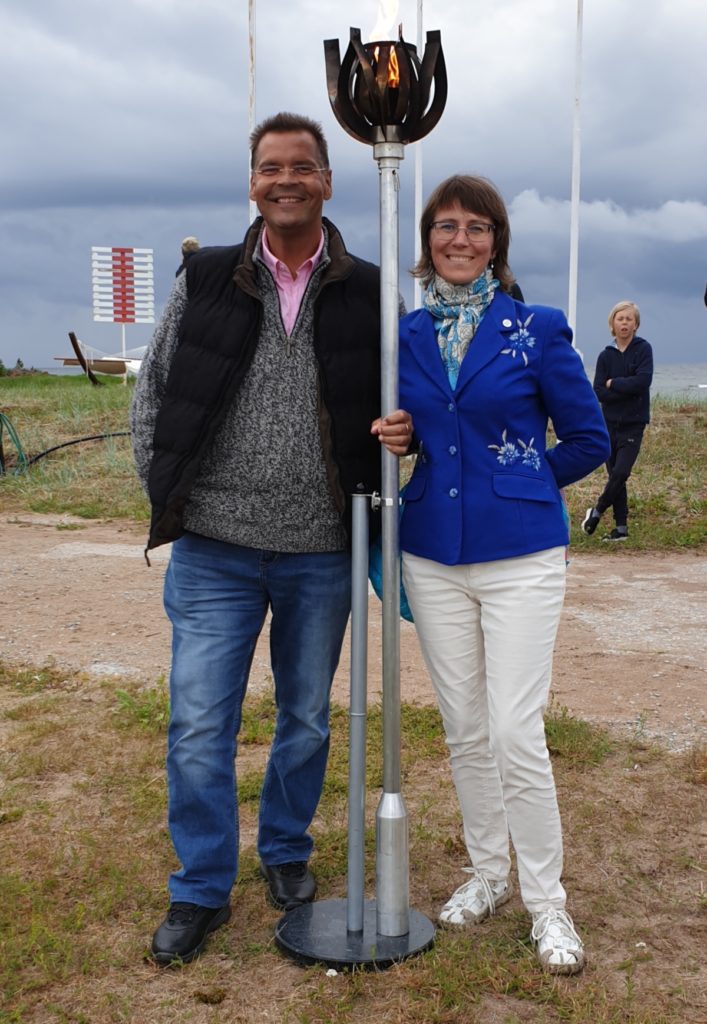
They insisted we stop at a branch of Muhu, Tallinn’s most famous bakery, to purchase a loaf of black leib, still warm from the oven, which we ripped off in chunks to nibble on as we drove. This bread, I have come to realize, is emblematic of the hardy Estonian people, their fortitude and spirit.
After a peaceful forest drive, we stopped for lunch at Ruhe, set picturesquely on the wild coast at Neeme. The temperamental wind blew the clouds dramatically and whipped up the waves furiously in changing shades of grey and blue. Inside, we shared an array of local fish, including whitefish tartar and sautéed herring with gorgeous garnishes of shaved beets and greens. I chose a soup – a clear broth in which were floating morsels of smoked eel, carrot and potato, pure flavours and sublime. They do soups very well here.
Today, city folk remain closely in touch with nature, our hosts explained. This is reflected in the cuisine, which is proudly local and fresh, so for example, local berries like juniper, crowberry, lingonberry and cloudberry feature prominently in the cuisine, as does seaweed from the seashore and moss from the forest.
As our driving tour continued we returned to the subject of Estonian pride. “It’s in our blood,” said Margit, an amateur singer. As she and Andrus recounted personal stories of the legendary Song Festival, Andrus put some traditional music on the car’s sound system. Within moments, we heard sniffles from Margit. “You see?” cried Andrus, throwing up his arm and before long, the car was trembling with emotion.
Back in Tallinn, we continued our pursuit of typical and contemporary Estonian cuisine. At first I was concerned that our busy concert schedule might challenge our food agenda. On the contrary, many Tallinn restaurants open in late morning and stay open all day, meaning we could find a fabulous meal at any hour.
Dinner at Ö is a revelation of local ingredients elevated with a mix of traditional and creative techniques: black pudding is served in a potato nest topped with smoked salmon cream. Cod mousse is served with fermented mushrooms topped with ‘dirt’ (crumbled black bread); local roach fish is salted and served with soured milk and roach roe; elk tartare is mixed with wild garlic, coated in beet dust and accompanied by smoked egg yolk. Wow!
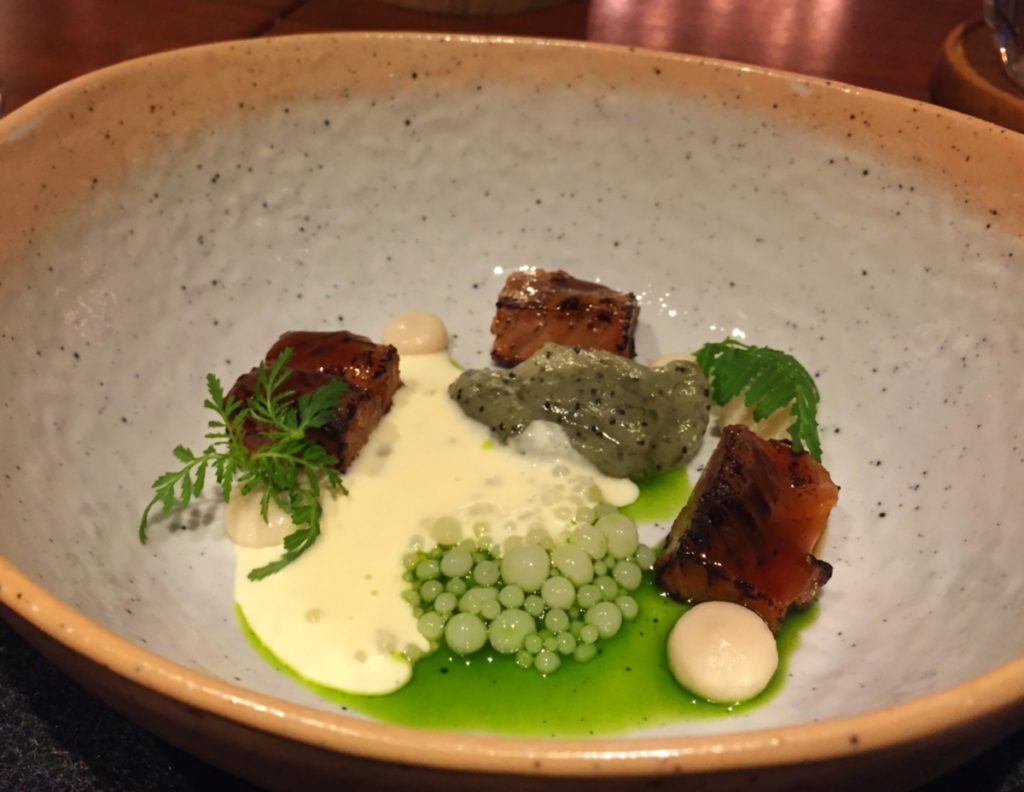
Next door is the restaurant Kaks Kokka, which shares the same kitchen and serves simpler but still very interesting food in a relaxed setting.
Tallinn is a vibrant city of old and new. The country wasted no time after declaring independence to modernize in every way. Just outside the Old Town the modern city is bustling, developing rapidly and thriving. It is the home of innumerable tech startups and is where Skype was invented.
The warehouses and factories in Rotermann Quarter have now been revitalized. There we find the wine restaurant R14, with a harmonious mix of old stone and brick with lots of wood and an exposed kitchen. Local business people rush in for a quick lunch of the dish of the day – always reasonably priced – then back to work. Those who linger can sip on a glass of wine or choose a bottle to take home from the well appointed wine cellar behind glass.
Just over the railway tracks, under a pitched roof, old limestone warehouses have been transformed into an exciting marketplace, the Baltic Station Market, with fresh fruits, vegetables, fish and meat, organic stores, prepared foods and eateries. Upstairs are vintage clothing and craft shops. Ambling along the railway tracks behind the marketplace, past rough graffiti-splashed fences, we find the very hip Telliskivi Creative City – where industrial warehouses have been transformed into a complex of designer boutiques.
Mingled among the shops are a number of restaurants, some spilling out onto the open spaces during the brief warm summer months, some specializing in craft beers. My favourite, F Hoone, a funky high-ceilinged space with tall plants, tiled floors and a casual vibe where you grab your own bread and water from the counter. Here I sampled some mushroom varenyky (perogies) with sour cream that even my Ukrainian-Canadian mother would appreciate.
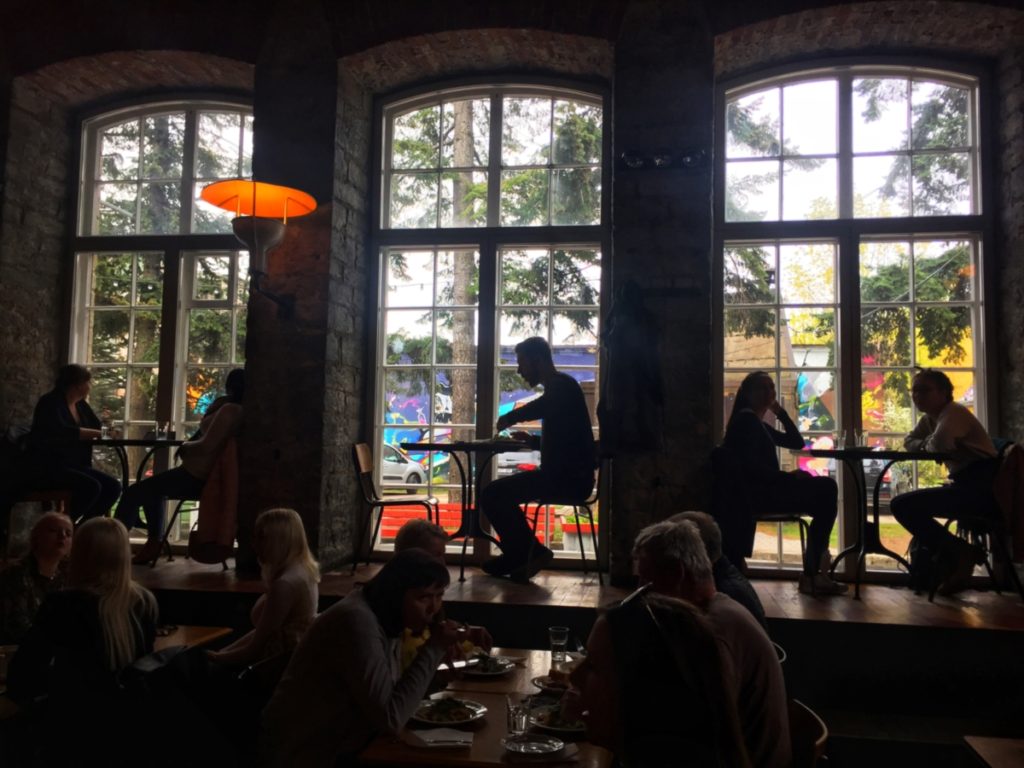
We tasted some very traditional specialties at Vanaema Juures (Grandma’s Place), like blood sausage with crowberry compote and pork and barley sausage nestled on a bed of porridge.
Another memorable restaurant just inside the old stone walls – noteworthy for its curious menagerie of stuffed wild animals in the foyer – is called Farm, an Estonian version of farm-to-table cuisine, offering a mix of traditionally inspired dishes with many creative surprises, like cod liver mousse garnished with egg and black bread crumbs.
On our final morning, we rushed back to the Baltic Station Market, to Muhu Bakery, to pick up a souvenir loaf of leib, hot from the oven, a bread that will sustain us for a week. Now that’s something to sing about.


